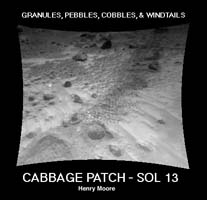 Moore_Fig1.jpg
Moore_Fig1.jpg |
This Sojourner rover image of the "Cabbage Patch" shows small
rounded objects on the surface that are about 3-4 cm across. Some of these
are within excavations, which are about 0.5 cm wide. Several questions arise
about the pebbles: 1. Why are they rounded? 2. Where did they come from?
3. What do they mean? Geologists use MULTIPLE WORKING HYPOTHESES when attempting
to explain observations. Some hypotheses that could account for the pebbles
are:
- They were rounded during transport by waters of catastrophic floods
and deposited on the Ares Vallis flood plain
- They were rounded by wave action on an ancient Martian beach
- They were rounded during glacial transport
- They are glasses that were produced by melting during impact cratering.
The glass was first ejected from the crater, then molded into spherical
shapes or drops as it traveled through the atmosphere, and finally was
deposited at the sites
- They are spatter from lava flows
- They are nodules brought up from the deep Martian interior by lava
flows or pyroclastic eruptions.
- They are concretions formed in sedimentary rocks
- They came from ancient conglomerate rocks. The pebbles were rounded
by water action and subsequently lithified into conglomerate rocks. Later,
the waters of catastrophic floods transported the conglomerates and deposited
them on the Ares flood plain. The pebbles were then freed from the rocks
by weathering.
- A combination of the above
|
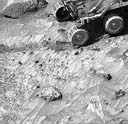 Moore_Fig2.jpg
Moore_Fig2.jpg |
| Pebbles are also seen in lander images, along with cobbles. For example,
in this picture, we see the same pebbles that were visible in the Sojourner
rover image of the "Cabbage Patch" (Figure 1). In addition, a
cobble within the rock "Lamb" (upper left) is apparent. This indicates
that Lamb may be a conglomerate (Lamb is 0.32 m x 0.15 m). |
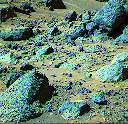 Moore_Fig3.gif
Moore_Fig3.gif |
| This color composite image from the Pathfinder lander shows the rock "Shark"
at upper right (Shark is about 0.69 m wide, 0.40 m high, and 6.4 m from
the lander). The rock looks like a conglomerate in Sojourner rover images,
but only the large elements of its surface textures can be seen here. This
demonstrates the usefulness of having a robot rover geologist able to examine
rocks up close. |
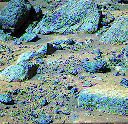 Moore_Fig4.gif
Moore_Fig4.gif |
| This color composite image of the "Rock Garden" shows the rocks
"Shark" and "Half Dome" at upper left and middle, respectively.
Between these two large rocks is a smaller rock ( about 0.20 m wide, 0.10m
high, and 6.33 m from the Lander) that was observed close-up with the Sojourner
rover (see Figure 6). |
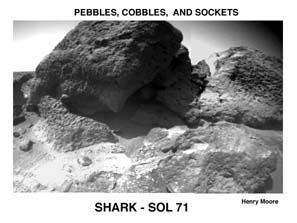 Moore_Fig5.jpg
Moore_Fig5.jpg |
| This Rover image of "Shark" (upper left center), "Half Dome"
(upper right), and a small rock (right foreground) reveal textures and structures
not visible in lander camera images. These rocks are interpreted as conglomerates
because their surfaces have rounded protrusions up to several centimeters
in size. It is suggested that the protrusions are pebbles and granules. |
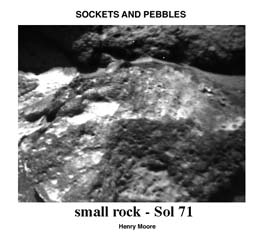 Moore_Fig6.jpg
Moore_Fig6.jpg |
| This close-up Sojourner rover image of a small rock shows that weathering
has etched-out pebbles to produce sockets. In the image, sunlight is coming
from the upper left. Sockets (with shadows on top) are visible at the lower
left and pebbles (with bright tops and shadowed bases) are seen at the lower
center and lower right. Two pebbles (about 0.5 cm across) are visible at
the lower center. |